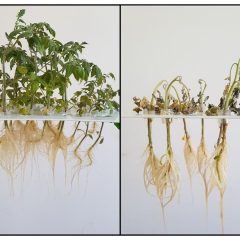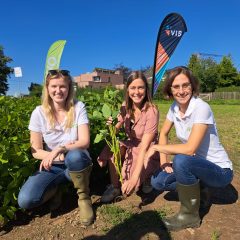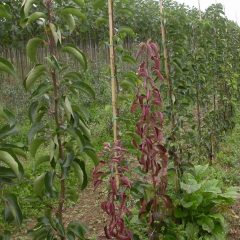Research project Preparing for the introduction of exotic strains of the Ralstonia solanacearum species complex (i.e. of Ralstonia pseudosolanacearum and Ralstonia syzygii) – valorisation of culture collections and validation of diagnostics and methods for
General introduction
This project dives deep into distinctions within the harmful plant bacterial family Ralstonia. A potential geographic expansion into our regions of 'exotic' strains of the RSSC (Ralstonia solanacearum species complex), while in fact a quarantine pathogen, has recently been noted, with a 'zero-tolerance' policy and associated monitoring efforts by plant protection services. These must then be provided with very up-to-date knowledge and techniques because of the scientific experts.
Bacteria belonging to RSSC are known to cause wilt in crops such as potato and tomato, and in ornamental plants such as Pelargonium and Anthurium. The RSSC includes four phylotypes classified into three different species: R. solanacearum (phylotype II), R. pseudosolanacearum (phylotypes I and III) and R. syzygii (phylotype IV). The best known in the EU is R. solanacearum phylotype IIB sequevar 1 (IIB-1), which gives (gave) brown rot to potatoes and thus disrupted European potato exports in the past. But R. pseudosolanacearum phylotype I, traditionally considered "tropical," has adapted to temperate climates since 2015, based on damage detected in ornamental and herbaceous plants in Europe.
Research approach
The researchers, in collaboration with the internationally specialized Euphresco network, are setting up a collaborative platform around the diagnostics, pathology and epidemiology of the 'tropical' species R. pseudosolanacearum and R. syzygii, and around othe general broader knowledge of the genetic diversity, population structure and evolutionary dynamics of these two strains. Efforts to harmonize detection and identification methods are also underway. The task of the ILVO bacteriology team is the inventory of bacterial strains, status updates regarding the occurrence of the two 'exotic' Ralstonia species in Belgium, the validation of diagnostic methods, the assessment of typing methods based on whole genome sequences, and the launch of an interactive tool for epidemiological monitoring.
Relevance/Valorization
Several plant species affected by Ralstonia bacteria are of economic importance to the EU. The results of this study will directly pay off in monitoring efforts under the current regulation as a quarantine pathogen. The competent authorities will have additional tools to limit the potential impact of Ralstonia on local agriculture and horticulture.
Financing
FOD Volksgezondheid, Veiligheid van de voedselketen en Leefmilieu







